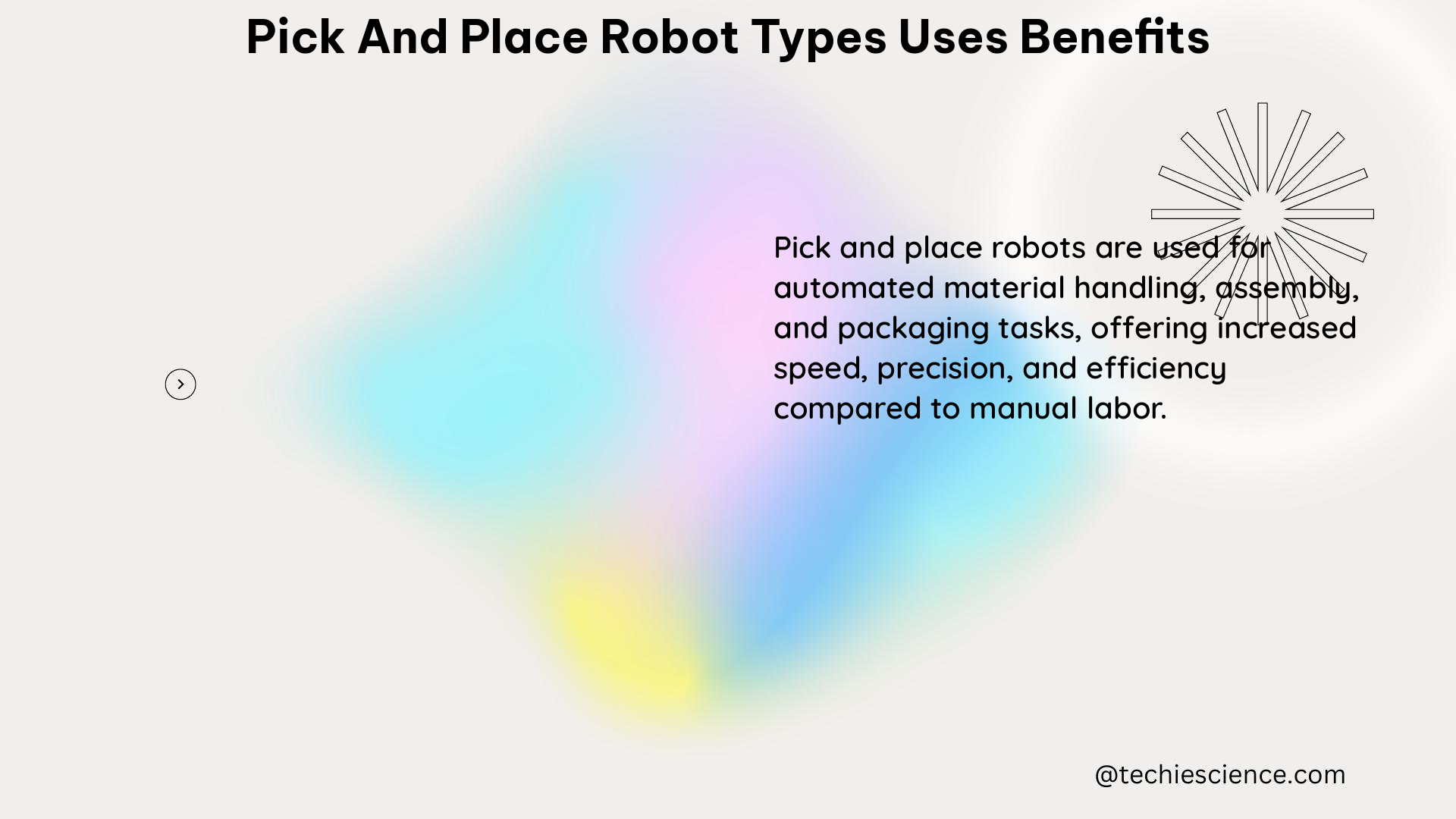Pick and place robots are industrial robots that are used for handling and placing products on a production line. They are typically used in high-volume manufacturing and logistics operations to automate the tasks of handling products. This comprehensive guide will explore the different types of pick and place robots, their unique features, and the measurable benefits they offer to manufacturers and logistics operations.
Types of Pick and Place Robots
Gantry Robots
Gantry robots consist of a beam that spans the width of a production line. They are often used in high-volume manufacturing settings, where they can quickly and accurately put items on production equipment. Gantry robots are known for their high speed and precision, making them ideal for applications that require rapid product handling and placement.
The key features of gantry robots include:
– Linear motion along the x, y, and z-axes
– Ability to handle heavy payloads
– High speed and accuracy
– Suitability for large work envelopes
Gantry robots are often used in industries such as automotive, electronics, and packaging, where they can automate the loading and unloading of parts, components, and finished products.
Articulated Robots
Articulated robot arms have a series of joints that allow the robot to move in multiple directions. They are often used in packaging applications, where they can place products into boxes or bags. Articulated robots are known for their flexibility and dexterity, making them well-suited for handling a wide range of products and performing complex tasks.
The key features of articulated robots include:
– Multiple degrees of freedom (typically 4-6)
– Ability to reach and manipulate objects in various orientations
– Compact design and small footprint
– Suitability for a wide range of applications
Articulated robots are commonly used in industries such as electronics, food and beverage, and consumer goods, where they can automate tasks like palletizing, depalletizing, and product assembly.
SCARA Robots
SCARA (Selective Compliance Assembly Robot Arm) robots have a horizontal arm and a vertical arm. They are often used in assembly applications, where they can pick up and move products onto a production line. SCARA robots are known for their speed, precision, and ability to operate in confined spaces.
The key features of SCARA robots include:
– Horizontal and vertical motion
– High speed and repeatability
– Compact design and small footprint
– Suitability for assembly and pick-and-place tasks
SCARA robots are widely used in the electronics, semiconductor, and medical device industries, where they can automate tasks such as component insertion, PCB assembly, and syringe filling.
Delta Robots
Delta robots consist of three arms that are mounted on a triangular base. They are often used in packaging applications, where they can place products into boxes or bags. Delta robots are known for their high speed, accuracy, and ability to perform rapid, repetitive motions.
The key features of delta robots include:
– Parallel kinematic structure
– High speed and acceleration
– Precise and repeatable motion
– Suitability for high-speed pick-and-place tasks
Delta robots are commonly used in the food and beverage, pharmaceutical, and consumer goods industries, where they can automate tasks like product handling, packaging, and palletizing.
Benefits of Pick and Place Robots

Pick and place robots offer a range of measurable benefits to manufacturers and logistics operations, including:
Increased Productivity
Pick and place robots can significantly increase the productivity of a manufacturing or logistics operation by automating the tasks of handling products. They can operate at high speeds, with consistent performance, and without the need for breaks or rest periods, leading to a higher throughput of products.
To measure the increase in productivity, you can track the number of products handled per minute or hour, and compare the performance of the pick and place robot to manual handling methods.
Improved Accuracy
Pick and place robots can improve the accuracy of product placement, which can reduce errors and improve quality control. They can precisely position products on production equipment or in packaging with a high degree of repeatability, minimizing the risk of misalignment or damage.
The improvement in accuracy can be measured by tracking the reduction in errors, such as the number of products that are misplaced or damaged during handling.
Reduced Labor Costs
By automating the tasks of handling products, pick and place robots can reduce the need for manual labor, leading to a decrease in labor costs. This can be especially beneficial in high-volume manufacturing and logistics operations, where the cost of labor can be a significant factor.
To measure the reduction in labor costs, you can compare the labor costs before and after the implementation of the pick and place robot, taking into account factors such as wages, benefits, and the number of workers required.
Increased Flexibility
Pick and place robots can be configured to handle a wide variety of products, making them suitable for use in a variety of settings. This flexibility allows manufacturers and logistics operations to adapt to changing product mixes and production demands without the need for significant changes to their automation systems.
The flexibility of a pick and place robot can be measured by the number of different products it can handle, as well as the ease with which it can be reprogrammed or reconfigured to accommodate new products or production requirements.
Improved Safety
Pick and place robots can improve safety by eliminating the need for workers to manually handle products. This can reduce the risk of workplace injuries, such as musculoskeletal disorders, and create a safer working environment.
The improvement in safety can be measured by tracking the reduction in workplace injuries and accidents, as well as the decrease in worker’s compensation claims and lost productivity due to injury-related absences.
Continuous Operation and Metrics
In addition to the benefits mentioned above, pick and place robots can also provide continuous operation, which can be especially beneficial in high-volume manufacturing and logistics operations. They can operate 24/7, providing consistent performance and reducing downtime due to errors or labor issues.
To measure the benefits of continuous operation, you can track metrics such as:
– Uptime: The percentage of time the robot is operational and performing its intended tasks.
– Throughput: The number of products handled per unit of time (e.g., products per minute or hour).
– Efficiency: The ratio of actual output to potential output, taking into account factors such as speed, accuracy, and reliability.
By monitoring these metrics, you can gain a deeper understanding of the performance and impact of your pick and place robot system, and make informed decisions about its optimization and future investments.
Choosing the Right Pick and Place Robot
When selecting a pick and place robot for your operation, it is important to consider the specific needs of your application, including the type of products being handled, the volume of production, and the available space and budget. Additionally, you should evaluate the robot’s speed, accuracy, flexibility, and ease of use and maintenance.
To ensure that you choose the right pick and place robot for your needs, it is recommended to work closely with a reputable robotics supplier or system integrator. They can provide expert guidance and support in selecting the appropriate robot, designing the optimal system configuration, and implementing the solution effectively.
By leveraging the benefits of pick and place robots and carefully considering the relevant metrics, manufacturers and logistics operations can improve their overall efficiency, productivity, and profitability.
References:
- How Do You Measure the Value of Robotics Projects?
- What is a Pick and Place Robot?
- What is a Pick and Place Robot? Uses and Types
- Advantages of Pick and Place Robots
- Pick and Place Robots: What Are They Used For and How Do They Benefit Manufacturers?

I have a background in Aerospace Engineering, currently working towards the application of Robotics in the Defense and the Space Science Industry. I am a continuous learner and my passion for creative arts keeps me inclined towards designing novel engineering concepts.
With robots substituting almost all human actions in the future, I like to bring to my readers the foundational aspects of the subject in an easy yet informative manner. I also like to keep updated with the advancements in the aerospace industry simultaneously.